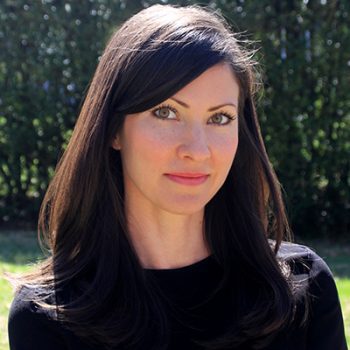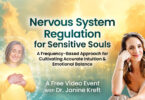July 29th, 2018
Have we gotten it all wrong? When we can move beyond fear into curiosity, we find that illness is the body’s wisdom playing out in its own highly designed and incredibly personal way.
The labels. Depression. Pertussis. Breast Cancer. Hashimoto’s. These are more than words – these are modern day hexes. They have this power because culturally-supported beliefs give meaning to our perception of these observed signs and symptoms. We create that meaning as a collective, and then we pass it on and around. We decide, together, what we will be afraid of. The list is curated and maintained by the media, and we are continuously learning and relearning when – and around what – to activate this fear response.
What is an anxiety disorder? Why is worrying a problem?
Does worry really make us sick?
Enter the nocebo effect.
[pro_ad_display_adzone id=”110028″]
Perhaps you’ve heard of the placebo effect, aka being “tricked” into feeling better by a sugar pill. Nocebo is the opposite, and it loosely translates to being “harmed by expectations” – but there is typically no sugar pill involved – just the power of belief. This phenomenon is called “expectancy” in the medical literature;for example, when subjects are told that they might be randomized to a sugar pill when trialing popular medications like Prozac, this belief can cause complete loss of reported benefits. even if they aren’t on the sugar pill![1] Interestingly, it seems that males’ responses depend more strongly on information given about placebo (aka intellectually-driven responses), whereas women are more sensitive to conditioned responses (aka felt) in the context of nocebo.[2] That is, female study subjects who merely witnessed another female reporting side effects from a medication were twice as likely to experience these side effects from a sugar pill/sham medication.[3] This is referred to as “social modeling.”
So if our culturally conditioned beliefs about harm and vulnerability can influence our physiology, then how do we understand this bodily response? Is the body just easily tricked, or is it responding intelligently to what we perceive as a conflict, distress, or danger? Perhaps it is possible that an experience of fear is actually what seeds the symptoms ultimately diagnosed as disease.
Ignoring the root cause – the wound
If we perceive fear-inducing distress in life, it likely stems from our pre-existing wounds. Francis Weller has categorized these wounds as isolation, loss, shame, separation from nature, and even the inheritance of family baggage. When we carry this grief, it colors our experiences and informs our personal alarm systems. And perhaps, this grief tells our bodies when and how to respond with symptoms. Once that response is underway, then we are invited to respond again to the symptoms themselves. Do we freak out and run to the ER? Or do we embrace the symptoms?
My teacher, Swaranpal , saw a shaman recently and had a transformative experience. The next day, she developed a fever and left me a message, from her bed, about how awesome it was that her body was processing the psychospiritual shift. A fever can, in fact, be awesome through the lens of appreciation for bodily wisdom.
Translating emotions to the body
This isn’t really news. The scientific discipline of psychoneuroimmunology has been around since the 1990s, telling us of a connection between the immune system, the psyche, and the brain. Dr. Candace Pert, NIH researcher and discoverer of the opiate receptor, was one of the first to legitimize that emotions encode in the body, a notion that could so easily be dismissed by the ‘body as machine’ model of medicine that has dominated the past 300 years.. This is one of the theories around how and why emotional releases and inexplicable healing can occur through yogic technology, such as kundalini yoga,that involves repetitive self-stimulation of certain body regions.
And this is why my greatest advocacy is to orient you around the story that speaks your truth. If you believe that challenges – and even adversity – hold a meaning, that the body has an innate wisdom, and that the cosmos operates under the principles of an elegant design, then you bend and flow with what comes. You bring curiosity to bear. And you live a life that is emergency-free.
To get there, you have to stop fighting the war, you have to relinquish your role as victim dependent on a system that holds all the answers that you yourself don’t have within. When we look, we see wartime narratives embedded throughout our consciousness. Like “fighting” depression, cancer, and germs.
Depression
We are led to believe that depression – and mental illness on the whole – is an inborn disease that results from imbalanced brain chemistry. Depression is a broken brain that you can’t do anything about – besides taking medications for life. This prognostic hexing has led people to literally commit doctor–assisted suicide because of their experiences of hopelessness induced by these psychiatric memes.
But what if we ask why depression is happening. What if we personalize it in a different way? Not by blaming a given individual’s broken brain and faulty genes, but by empowering them to explore its roots. And to reunite with their symptoms as messenger, not enemy. The smoke alarm, not the fire.
I believe that the outcomes[4] that I have in my practice are largely attributable to the container of fearlessness that I create. A safe haven for all and every ugly emotion to surface and transmute. Where the words “worry” and “concern” are eliminated from our shared vocabulary, and where every aspect of the experience of symptoms becomes a meaningful missive to interpret in the context of the patient’s lifescape. Without this fear, we are able to receive any and all of what comes without resistance, and with more open arms, allowing for dramatic reversals to unfold.
Cancer
My mentor, the late, great Dr. Nicholas Gonzalez, was one specific influence in my life that reinforced this fearless approach to illness. He helped to blast away any residual carve-outs -any circumstances in which I might say, ‘well that does require conventional medicine.’ As I studied and learned of his natural healing protocol that enabled decades-long outcomes with terminal cancer patients, I knew that there was, indeed, nothing to be afraid of. Ever. And when patients who had otherwise been hexed by the medical establishment met with him, they too shed their fear in favor of faith in the body’s capacity to self-regulate and heal, even if part of the healing looked like sickness. And they did heal, by the hundreds.
While Nick had a protocol based on personalized nutrition, detox, and supplementation (one that has greatly informed my own), is it possible that this protocol only fortified the body’s self-healing response, but that it wasn’t actually what healed the patient?
[pro_ad_display_adzone id=”110030″]
Proponents of Dr. Hamer’s German New Medicine would argue that the body develops cancer as a part of a highly meaningful biological program that limits itself once the original psychic conflict is resolved – aka disease is actually adaptive and evidence of a healing process already underway. Dr. Hamer believed that psychic conflict , and particularly shocking conflict that is perceived as distressing gives rise to a corresponding physiologic process that includes changes in cellular proliferation of organs. This process spontaneously resolves (with the help of the inner microbiome) when the conflict is addressed. This notion helps explain data on repressed anger as a top cancer risk and reaffirms that perception and cultural context are at the core of disease.
The most compelling aspect of German New Medicine is that it recontextualizes cancer as “nothing to be afraid of;” what we think of as cancer is simply the body’s secondary process of resolving the psychic injury of the cancer diagnosis itself, as reported on by Sayer Ji of greenmedinfo.com. Even conventional medicine agrees that certain early stage cancers, like DCIS breast cancer, thyroid cancer, and prostate cancer, should be left alone, as the ‘treatments’ do nothing to prolong life and instead are likely detrimental.
In fact, ‘treatment’ with chemotherapy and radiation not only disrupts a complex process that needs to actually be supported, but also it induces secondary harm, both psychically and physiologically. When we interfere and war with the body, we keep the fight alive – you can’t win the battle against yourself.
Infection
Preschool-level depictions of the immune system as a troop of soldiers fighting off the enemy germ invader has always inspired an internal eyeroll, but it wasn’t until my deep dive into the complexity of immunology that I came to understand that we know nothing of it. In fact, the vast majority of immunology is thoroughly and completely devoted to vaccinology. For all intents and purposes, medicine doesn’t care to learn about the immune system outside of how it’s poking and prodding can support the illusion that vaccines have beneficial effects.
Wait, vaccines must have beneficial effects if they produce antibodies, right? Antibodies have been deemed synonymous with disease protection, and even used a surrogate markers for claims that vaccines “work” in the laboratory setting, but is there actually any science for this? And do the antibodies produced upon vaccination actually bind to and inactivate disease-causing agents? What if antibodies are simply response elements[5] that support the body’s reaction to the many toxic chemicals in vaccines, ranging from detergents like polysorbate 80 to formaldehyde?
And what about contagion? Has it ever actually been proven that germs travel from one person to another and infect them? Does a yawn spread that way? What about women’s menstrual cycles syncing up when they live together? What about fear-induced illness, which is strikingly demonstrated in a study in which women who were convinced that they were inhaling “contaminated air” got sick when they saw others get sick from it – despite the fact that there was nothing wrong with the air.[6] Then there’s people who only get symptoms of the cold when they believe themselves to be unwell at baseline; perhaps they sense not their immunological vulnerability, but the need for their body to take an opportunity to rebalance.[7]
I have come to believe that infectious signs are evidence that the body knows how to, and needs to, eliminate. Vomiting, diarrhea, sweating, coughing, sneezing, and runny noses all have exudative elimination in common. I choose to believe that these are healing processes, the same way that pediatricians of old who saw children through experiences of so-called infectious illness witnessed them enjoy milestones of growth in the wake of these processes.
As we sit in even more curious territory, what other assumptions have we made that have been disproven or remain unproven to date? Science can be a beautiful tool for discovery, but only if it is allowed to dispassionately acknowledge when a more complete picture is emerging. Germs as pathogens is a complex question that science has contributed rich literature to in the past two decades. With the dawn of the microbiome – our inner ecology that reveals not only our harmonious relationship to but our dependency on the very microbes we have demonized – everything about orthodox medicine should have changed. Including the discovery of so-called viruses embedded in our own genomic material, calling into question whether or not viruses actually exist in the way we have assumed. Has a discrete virus, deemed unable to exist independently, ever been visualized under electron microscopy – or are we still inferring? What about exosomes – the packets of genetic material that travel between the environment and our physiology and influence gene expression? Science is revealing that these exosomes look a little too much like viruses for our comfort, leaving us, once again seeing the enemy as a critical part of ourselves.
What does healing look like?
So, if fear is the sickness, then what is the cure? It’s possible that it is as simple as a shift in mindset and a reframing of the felt experience of the body. In fact, that may be all that Dr. Gonzalez, Dr. Hamer, and I are here to do – engender an experience of trust in the body, in the journey, and in the exquisite design of it all through our beliefs, our lived experience, and our outcomes. To introduce a new story, where no one is a victim of bad genes, bad luck, and an unwanted lifelong relationship with the pharmaceutical industry. You have a choice to bring curiosity to this challenge, to support your body through it rather than interfere with it, and to uplift a sense of your truest self, which lies underneath the experience of physical healing. In this way, you put a soundtrack to your life that says, “isn’t this interesting” and “there’s nothing to worry about” and “you’ve got this” instead of one that says “but what if I don’t…” and “I couldn’t live with myself if…” and “what would everyone think if…” and “why is this happening to me? It’s so unfair.” It’s happening to you because it is a part of you. The experience of illness is so deeply meaningful and purposeful that it is, quite literally, showing you, yourself. Embrace it. Because “everything you’ve ever wanted is on the other side of fear.”
References:
- [1] http://article.psychiatrist.com/dao_1-login.asp?ID=10008673&RSID=78057979144618
- [2] https://www.ncbi.nlm.nih.gov/pubmed/28831271
- [3] https://www.ncbi.nlm.nih.gov/pubmed/25545042
- [4] https://www.ncbi.nlm.nih.gov/pubmed/28659508
- [5] http://www.sciencedirect.com/science/article/pii/S0928468012000818
- [6] https://www.ncbi.nlm.nih.gov/pubmed/17291177
- [7] https://www.ncbi.nlm.nih.gov/pubmed/26397938
Also by Kelly Brogan, M.D.
- Psych Meds Put 49 Million Americans at Risk for Cancer
- Are You Fluoridated?
- 5 Rules for Eating Away Your Depression
- Confessions of a Renegade Psychiatrist
About the author:
Dr. Kelly Brogan is boarded in Psychiatry/Psychosomatic Medicine/Reproductive Psychiatry and Integrative Holistic Medicine, and practices Functional Medicine, a root-cause approach to illness as a manifestation of multiple-interrelated systems. After studying Cognitive Neuroscience at M.I.T., and receiving her M.D. from Cornell University, she completed her residency and fellowship at Bellevue/NYU. She is one of the nation’s only physicians with perinatal psychiatric training who takes a holistic evidence-based approach in the care of patients with a focus on environmental medicine and nutrition. She is also a mom of two, and an active supporter of women’s birth experience. She is the Medical Director for FearlessParent.org, and an advisory board member for GreenMedInfo.com.
You can visit her website at kellybroganmd.com where this article first appeared. © Kelly Brogan MD. This work is reproduced and distributed with the permission of Kelly Brogan MD. For more articles, sign up for the newsletter at kellybroganmd.com.
[pro_ad_display_adzone id=”110027″]








